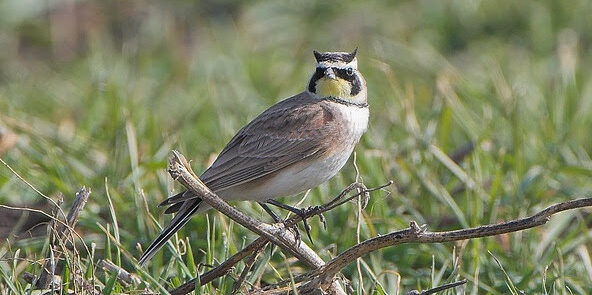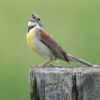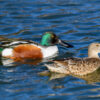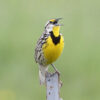Horned Lark, Eremophila alpestris
Bill Rowe
Wide-open agricultural fields, especially those that are mostly bare soil, may seem to be the least likely places to find birds—yet this is standard habitat for one of our widespread North American species, the Horned Lark. Actually, it’s widespread all over the Northern Hemisphere, but in Eurasia it shares its range with other kinds of larks, scores of them, while over here it is the only representative of that successful family, with the exception of a very local introduced population of Eurasian Skylarks around Vancouver, Canada. (Note that our American meadowlarks are not larks, but icterids, or blackbirds.) A typical winter encounter in the Midwest might be to flush a few Horned Larks from a roadside, pause for a look, and then realize that a flock of fifty or a hundred was taking off from the nearby fields, circling around, and settling back down to start foraging for seeds again. These wintering and migrating flocks may be joined by Lapland Longspurs but few other birds; even the sparrows of open country prefer more cover. Come February and March, the flocks disperse as the male-female pairs form and set up their individual territories for nesting. At the same time, the males begin singing their high-pitched jingling song, a characteristic sound of the open fields in spring. Away from agricultural areas, larks will make their home in grassy airfields, short-grass prairie, desert, or the tundra above treeline in our western mountains, where you may see them if you are vacationing in, for instance, Rocky Mountain National Park.
IDENTIFICATION: At a distance, Horned Larks are trim birds, brownish above and whitish below, with black tails, a little larger than most sparrows. Close up, the males are handsome and unmistakable with their black mask and chest patch, yellow throat, and little feathered “horns,” while females have the same face pattern but in a less contrasty brown. Juvenile birds are profusely speckled and more puzzling.
ST. LOUIS STATUS: Generally present at all seasons in the right habitat, but more numerous in migration and winter, when they accumulate into large flocks. They are always birds of the countryside, never in cities except perhaps on a golf course.
Learn more and listen to the songs and calls of Horned Larks here.

Female

Juvenile
Photo Credit: Al Smith




